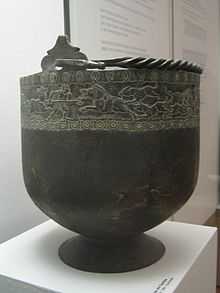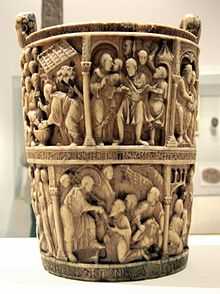Situla (vessel)

Situla, from the Latin for bucket or pail, is a term for a variety of elaborate bucket-shaped vessels from the Iron Age to the Middle Ages, usually with a handle at the top. All types may be highly decorated with reliefs in bands or friezes running round the vessel.
Typically Iron Age situlas are bronze, as in the types of libation vessels found as grave goods in the Hallstatt region of Central and Southeast Europe and Etruscan art, where they have a distinctive style known as "situla art"; the Vače situla is an example. These usually have a short narrower neck. Numerous Hallstatt situlas were found in Slovenia, mainly (19 of them) in the area of Novo Mesto in Lower Carniola, which has been named the "City of Situlas" due to this.[1][2]
Situla is also the name for types of bucket-shaped Ancient Greek vases, some very finely painted.[3] More utilitarian pottery situlae are also found, and some in silver or other materials,[4] such as two Late Antique glass ones in St Mark's, Venice.
Attribute of Isis

The term is also used for pails carried by figures in other art forms; according to Plutarch and other sources this was a sign of a devotee of Isis, who herself is often shown carrying one (containing water from the sacred Nile), of a rather different shape, with a rounded bottom, and sometimes lidded. This rounded shape, often with a "nipple" at the bottom (see Luristan example in gallery), is believed to have represented the female breast.[5] These were also donated to temples as votive offerings by devotees.
Christian situlae
Elaborate early medieval situlae were Christian liturgical objects used to hold holy water, also usually of bronze, and straight-sided with a handle. An aspergillum was dipped in the situla to collect water with which to sprinkle the congregation or other objects. Four richly carved ivory examples from the 10th century are known: the Basilewsky Situla of 920 in the Victoria & Albert Museum, decorated with scenes from the Life of Christ on two levels,[6] the "Situla of Gotofredo" of c. 980 in Milan Cathedral,[7] one in the Aachen Cathedral Treasury,[8] and one in the Metropolitan Museum of Art in New York.[9] All came from the milieu of the Ottonian court: an inscription says that Archbishop Gotfredus presented the Milan example in anticipation of a visit by the Emperor,[10] also referred to in the London example which was possibly from the same workshop.[11] The latest and most lavish is the Aachen example, which is studded with jewels and shows an enthroned Emperor, surrounded by a pope and archbishops. This was probably made in Trier about 1000.[12]
Outside Europe
The term may also be used for similar vessels from other cultures, especially the ancient Middle East and China and Vietnam.[13]
Bronze bath buckets are also found in Islamic art, such as the 12th century Persian Bobrinsky Bucket in the Hermitage Museum.
Gallery
-

Situla from Luristan, 9th century BC
-
Etruscan "Situla della Pania", 7th century BC
-
.jpg)
The situla from Vače
-
_med_drifna_ornament%2C_Nordisk_familjebok.jpg)
Reproduction of Etruscan bronze situla
-

Priestess of Isis carrying situla, Roman statue, Second Century, B.C.
-
Reproduction of bronze situla, Vorstengraf Oss, with one of the oldest iron sword found in the Netherlands
See also
| Wikimedia Commons has media related to Situlae. |
Notes
- ↑ "Novo mesto bogatejše še za eno poslikano situlo" [Novo mesto Richer for Another Painted Situla] (in Slovenian). Lokalno.si. 6 February 2006. Retrieved 15 December 2010.
- ↑ "Application for the Title of the European Capital of Culture 2012". City Municipality of Maribor. 2008.
- ↑ MFA Boston, Attic vase situla
- ↑ Kipfer, 518
- ↑ Witt, 55. Isis situla
- ↑ Basilewsky Situla V&A Museum
- ↑ image of Milan situla
- ↑ Image of Aachen situla
- ↑ Metropolitan Museum example
- ↑ Lasko, 92-3
- ↑ Though Lasko, 92 disagrees with this.
- ↑ All except the New York situla are illustrated and discussed in Beckwith, pp.129-130, 135-136
- ↑ Metropolitan, Vietnamese bronze situla
References
- Beckwith, John. Early Medieval Art: Carolingian, Ottonian, Romanesque, Thames & Hudson, 1964 (rev. 1969), ISBN 0-500-20019-X
- Kipfer, Barbara Ann. Encyclopedic dictionary of archaeology, Springer, 2000, ISBN 0-306-46158-7, ISBN 978-0-306-46158-3.Google books
- Lasko, Peter, Ars Sacra, 800-1200, Penguin History of Art (now Yale), 1972 (nb, 1st edn.) ISBN14056036X
- Witt, Reginald Eldred. Isis in the ancient world, JHU Press, 1997 (2nd ed), ISBN 0-8018-5642-6, ISBN 978-0-8018-5642-6. Google books
Further reading
- Beckwith, John. The Basilewsky Situla, 1963, HMSO
- Kastelic, Joze, and Karl Kromer, Guido Mansuelli. Situla Art: Ceremonial Bronzes of Ancient Europe, NY McGraw-Hill 1965

_01.jpg)
